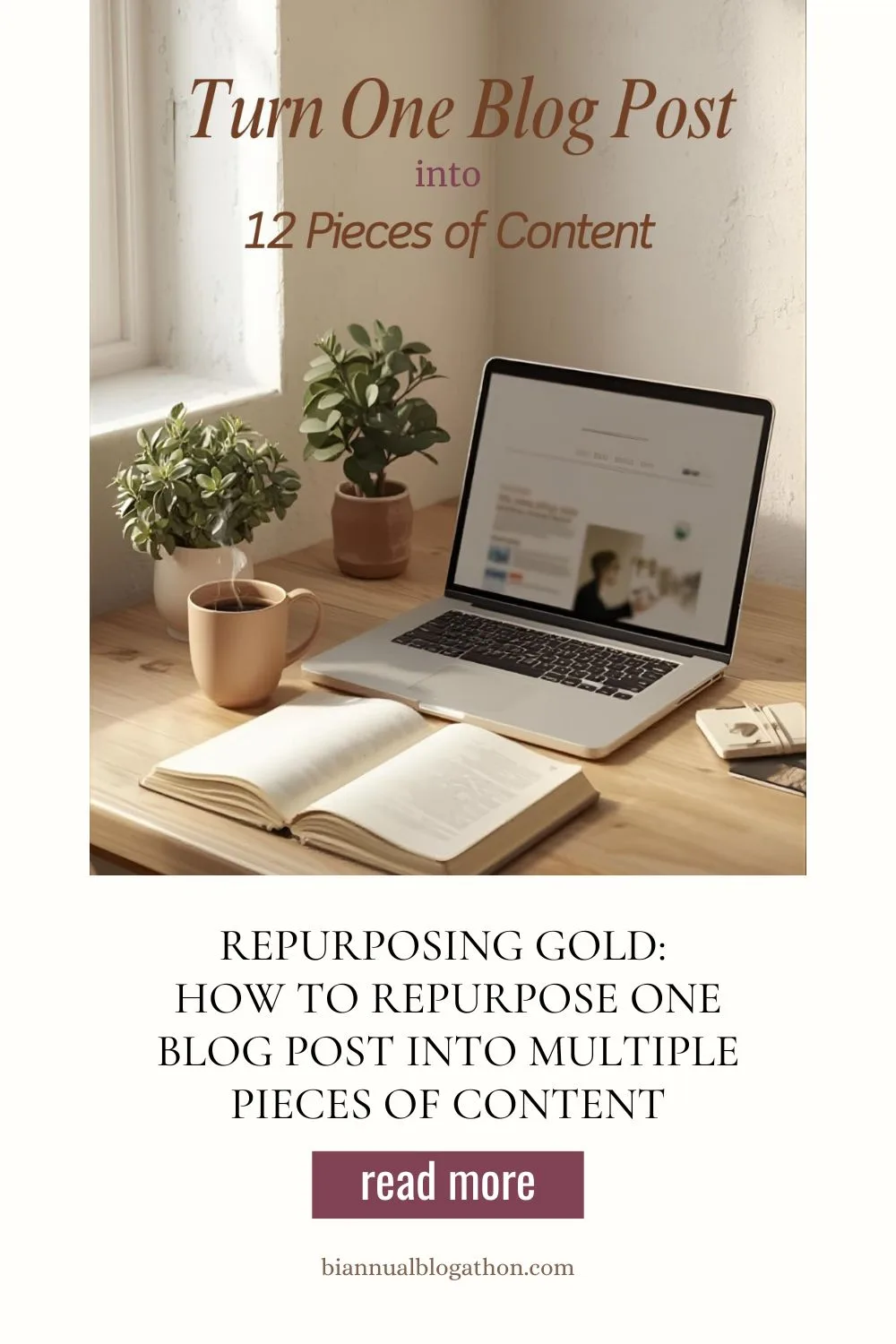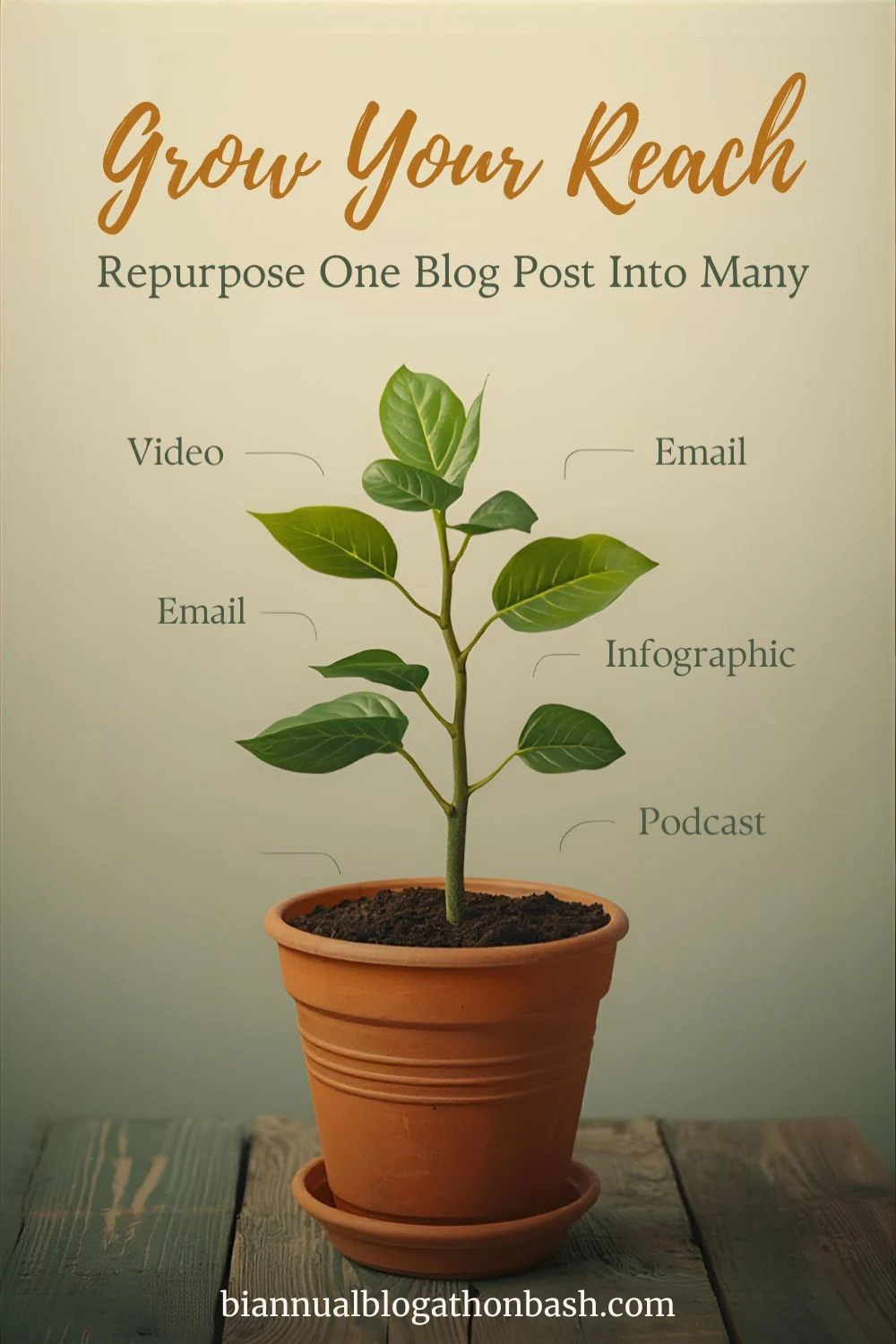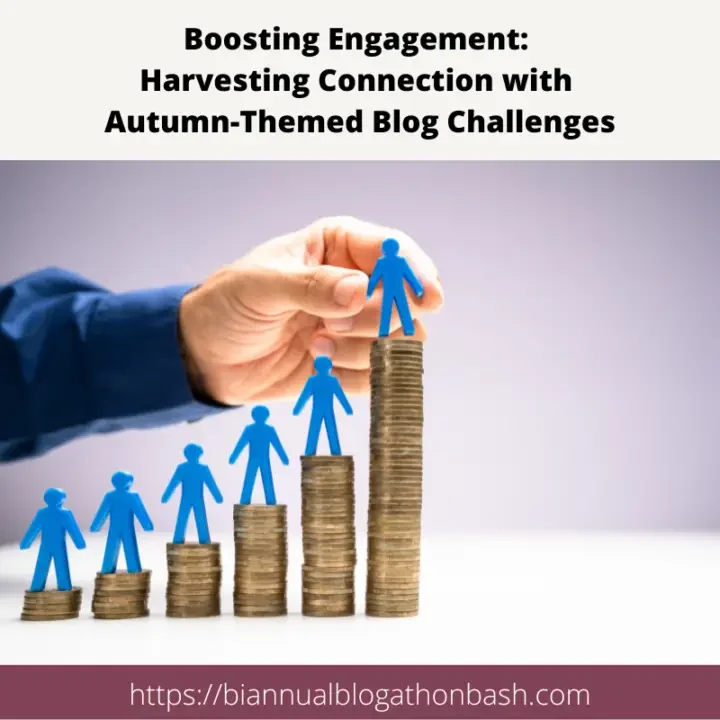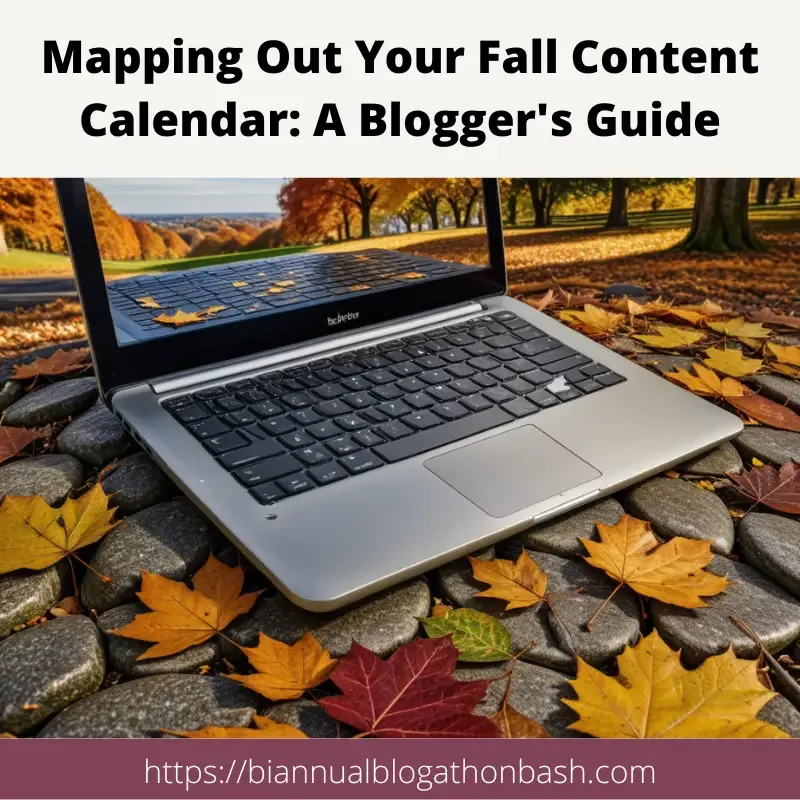If you’ve ever wondered how to repurpose one blog post so it keeps working long after you hit publish, you’re in the right place.
I know that feeling of pouring your heart into a post, sharing it once, and watching the traffic vanish within days - I’ve been there too.
The truth is, most bloggers spend hours creating content that only shines for a moment.
But that same post holds so much untapped potential.
With a little creativity and planning, you can transform it into videos, emails, printables, or social media posts that continue to bring readers back week after week.
Think of it like tending a content garden - your blog post is the “mother plant,” full of ideas ready to grow.
Each cutting, whether it’s a quote graphic or a podcast episode, becomes something fresh that helps your blog thrive without the burnout.
Why Repurposing Content Is Pure Gold
Repurposing content isn’t about being lazy or repetitive - it’s about being smart with your time and energy.
You’re taking one solid idea and adapting it to fit how different people consume information.
-
Some people love watching videos.
-
Others prefer reading.
-
Some scroll through social posts or pin infographics.
When you repurpose, you meet your audience where they already are - and you give your best content more chances to shine.
As a homesteader and blogger myself, I like to think of repurposing as preserving your hard work - kind of like canning tomatoes at the end of the season.
You’re saving up the goodness so you can enjoy it later, in all sorts of ways.
Step 1: Choose Your Core Piece of Content
Start with one blog post that’s done well or that represents your expertise.
It could be a tutorial, a story, or an evergreen guide.
Examples:
-
“How to Preserve Fall Apples Without Canning” (food preservation niche)
-
“Beginner’s Guide to Container Gardening for Small Spaces” (gardening niche)
-
“Five Simple DIY Cleaning Recipes That Actually Work” (homesteading niche)
You’ll use this as the base - everything else grows from here.
Step 2: Create a Short Video Summary
Take the key takeaways from your post and turn them into a short video - 60 to 90 seconds for TikTok or Reels, or up to 3 minutes for YouTube Shorts.
You can do this with a simple talking-head video, a voiceover with photos, or even short clips of you demonstrating your tips.
Example:
If your post is about preserving apples, film yourself slicing, freezing, and labeling them. Add quick captions:
“Step 1: Slice evenly.”
“Step 2: Freeze flat before bagging.”
“Step 3: Label for easy storage.”
Mention your full post in the caption and add your link in bio or description.
👉 SEO Tip: Use keywords naturally in your video title and caption. For instance, “How to Freeze Apples the Easy Way - No Canning Required.”
Step 3: Record a Podcast Episode
Podcasting is one of the easiest ways to repurpose a blog post.
Simply use your post as a script or outline.
Talk through the points conversationally - like you’re chatting with a friend over coffee.
You can add extra context, personal stories, or behind-the-scenes insights you didn’t include in the written version.
Example:
If your post is about “Starting a Victory Garden,” share what inspired you to grow your first garden, what worked (and what didn’t), and how you learned to deal with pests naturally.
👉 AEO Tip: Use clear, descriptive language when introducing your episode, such as “In today’s episode, I’m breaking down how to start a victory garden from scratch - including soil prep, layout tips, and the easiest crops for beginners.”
Step 4: Create an Infographic
Visual learners love a good infographic!
Summarize the key points from your post using icons, short phrases, and step-by-step layouts.
Tools like Canva or Venngage make this easy - and you don’t need to be a designer.
Example:
For a post about “Composting 101,” make an infographic titled “What to Compost vs. What to Skip.”
Use little icons of banana peels, eggshells, and paper towels on one side - and meat, dairy, and plastics on the other.
Pin it to Pinterest, post it on LinkedIn, and embed it back into your original blog post for extra SEO value.
Step 5: Design a Carousel for Instagram or LinkedIn
Carousel posts grab attention because they invite readers to swipe through your ideas.
Take your main points and make each one its own slide.
Example:
If your blog post is “10 Ways to Save Money on the Homestead,” make each slide one tip - from bartering with neighbors to making your own cleaning supplies. End the last slide with a call to action: “Read the full guide at ExperimentalHomesteader.com.”
👉 SEO Tip: Add alt text to each image slide. For example: “homesteading money-saving tips graphic - make your own cleaning supplies.”
Step 6: Turn It Into a Live Stream Topic
If you’re comfortable on camera, go live!
It doesn’t have to be fancy - just you talking about your topic, sharing stories, and answering questions.
Live streams build authenticity and connection.
Example:
You could do a Facebook Live about “Easy Ways to Extend Your Garden Season.” Show your cold frame setup, talk about your favorite crops for fall, and answer audience questions in real time.
Then, download that video and post it to YouTube, embed it in your blog, and clip short highlights for Reels or Shorts.
That’s four content pieces from one video!
Step 7: Make a Printable or Checklist
If your original post is educational, it’s easy to create a downloadable version.
Example:
From a post about “How to Preserve Fall Herbs,” you can create a “Herb Preservation Checklist” with drying, freezing, and oil infusion steps.
Add a cover page, some friendly visuals, and brand colors, then offer it as a lead magnet to grow your email list.
👉 AEO Tip: Use phrases like “Download your free herb preservation checklist” so voice search tools pick it up clearly when people ask, “Hey Siri, how can I preserve herbs for winter?”
Step 8: Write an Email Teaser
Don’t copy your whole post into your newsletter.
Instead, share a short teaser that leads back to your site.
Tell a quick story, share one valuable takeaway, and include a link to read the full post.
Example:
“I spent last weekend preserving apples, and it reminded me how grateful I am for freezer space! If you’re wondering how to preserve your apple harvest without pulling out the canner, I just posted a full step-by-step guide on the blog. Check it out here → [link].”
That friendly tone builds connection and gets clicks.
Step 9: Create Pinterest Pins (Lots of Them!)
Pinterest thrives on fresh visuals.
You can make multiple pin designs for the same post - different titles, colors, or images - and link them all to your original article.
Example Titles:
-
“How to Preserve Apples Without Canning”
-
“The Lazy Homesteader’s Guide to Apple Preservation”
-
“No-Canning Apple Storage Hack You’ll Love”
👉 SEO Tip: Use keywords in your pin descriptions: “Learn how to preserve apples without canning. Perfect for busy homesteaders and gardeners who want to enjoy fall fruit all year long.”
Step 10: Pull Out Social Media Quotes
Your post is full of quotable lines - don’t let them go to waste!
Highlight one or two per week in branded quote graphics.
Pair them with photos of your garden, kitchen, or workspace.
Example:
From a gardening post:
“Seeds are tiny promises - and every season is a chance to keep them.”
From a blogging post:
“You don’t need to create more content. You need to make your existing content work harder.”
These are relatable, shareable, and they reinforce your brand voice.
Step 11: Write a Thread or Mini-Series of Posts
On X (Twitter) or Facebook, you can break your article into a short series.
For instance, if your post is about “Repurposing Content,” start a thread like:
1️⃣ Step 1: Pick one evergreen post.
2️⃣ Step 2: Turn it into a video.
3️⃣ Step 3: Share a quote graphic.
Each post builds on the previous one, keeping people coming back for more.
👉 SEO + Engagement Tip: Include one call to action at the end: “Read the full guide for all 12 repurposing ideas → [link].”
Step 12: Create a Slide Deck or Presentation
If your blog post is educational (and most are), it’s easy to turn it into slides for workshops, webinars, or courses.
Example:
Your post “How to Start a Compost Pile” could become a PowerPoint for a local gardening class. You can even upload it to SlideShare for added visibility and backlinks.
That same deck can be repurposed again - as a downloadable PDF or part of an online course bundle.
Step 13: Update and Expand It into a New Post
After a few months, revisit your original article.
Add new data, experiences, or reader questions.
You can even turn it into a series:
Example:
“Preserving Apples Without Canning” could evolve into:
-
“5 Common Mistakes to Avoid When Freezing Apples”
-
“Best Containers for Freezing Fruit Without Waste”
Link all posts together for stronger SEO and longer reader sessions.
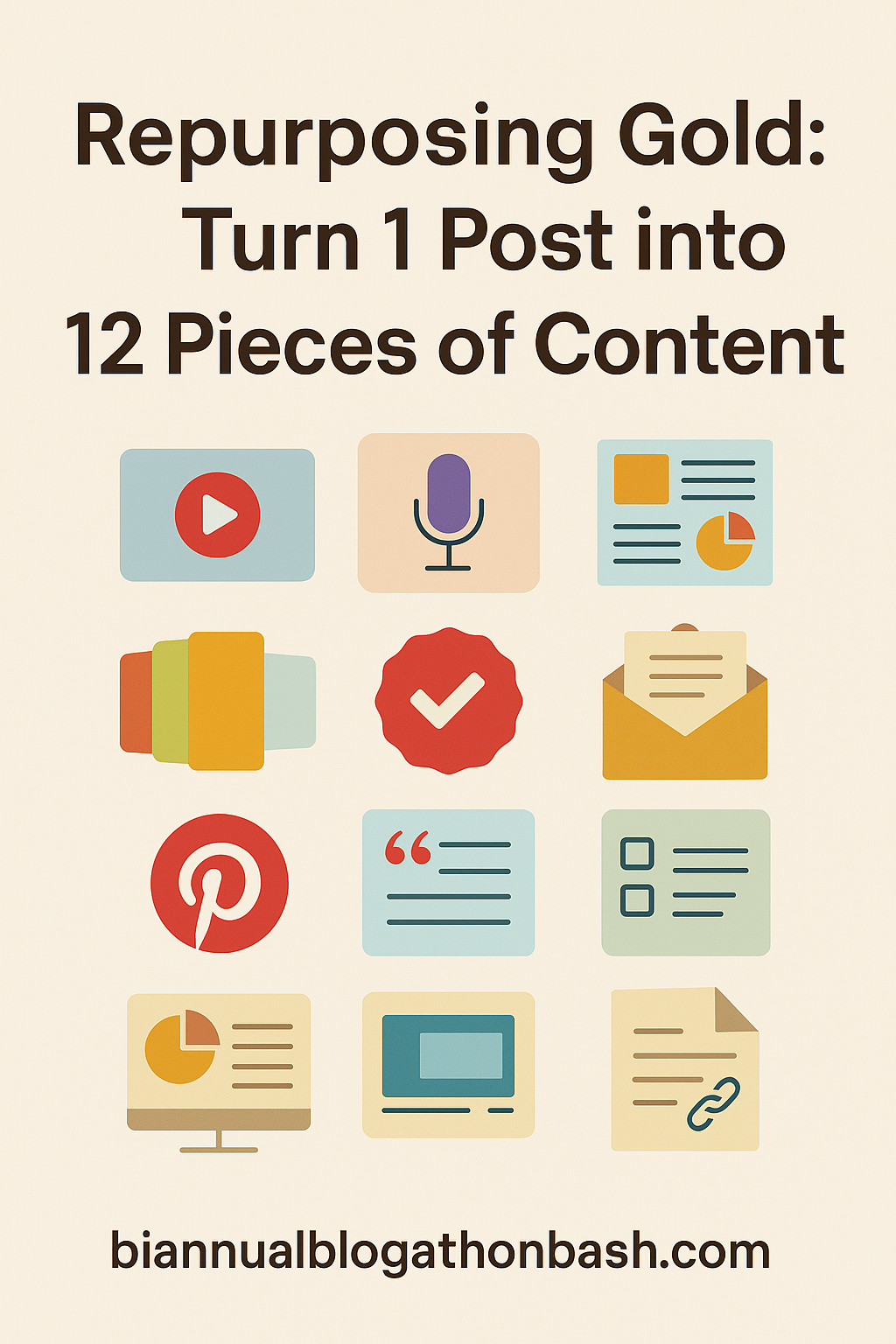
Bonus Tip: Combine Multiple Formats into a Campaign
Once you get comfortable repurposing, you can plan whole campaigns around one post.
For example:
-
Write a blog post about “Making Homemade Yogurt.”
-
Create a short video of the process.
-
Turn the steps into a printable recipe card.
-
Share a quote graphic: “Homemade yogurt tastes like self-sufficiency in a jar.”
-
Email your subscribers a quick story about your first time making it.
Now you’ve got blog, video, email, and social media content - all consistent, all cohesive.
Repurposing Is About Working Smarter, Not Harder
When you start thinking of your blog posts as living, breathing content that can evolve into new forms, you’ll never run out of things to share.
You’ll spend less time creating from scratch and more time connecting with your audience - and that’s where the real magic happens.
Whether you’re teaching people to garden, preserve food, or build a blog of their own, the same rule applies: don’t waste good material.
Just like a well-tended garden, the more care you put into repurposing your content, the richer your harvest will be.
So, the next time you publish something you’re proud of, don’t move on too quickly.
Let it grow - one format, one platform, and one audience at a time.
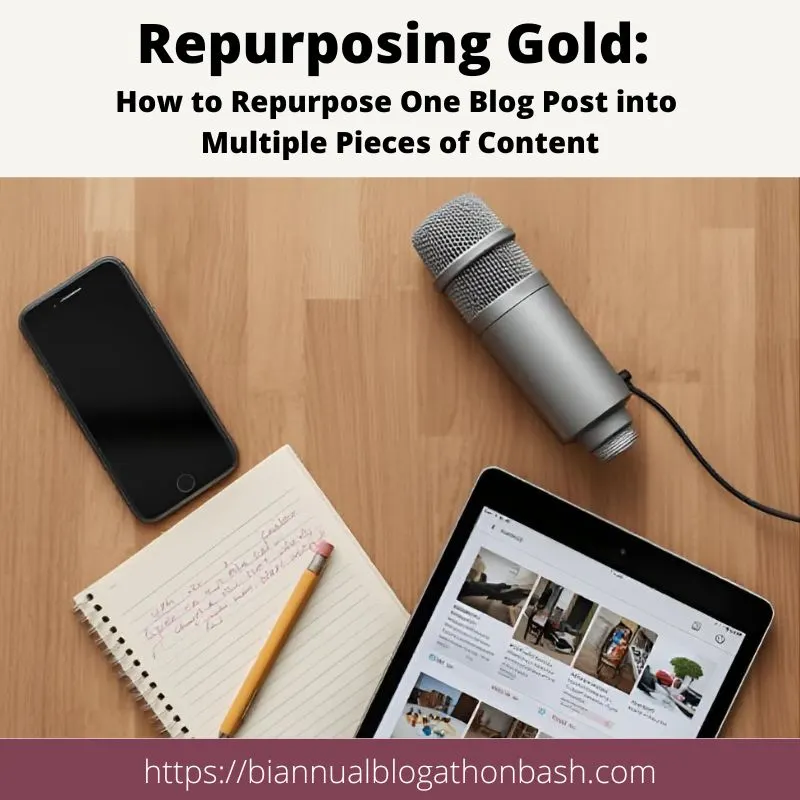
Frequently Asked Questions About Repurposing Blog Content
Q. What does repurposing content mean?
A. Repurposing content simply means taking an existing piece of content - like a blog post, video, or podcast - and adapting it for a new format or platform.
For example, you might turn a how-to blog post about preserving apples into a short video for YouTube, a step-by-step printable checklist for your email subscribers, or a carousel post on Instagram. You’re not rewriting the same thing over and over - you’re reshaping your message so it fits how people prefer to consume information.
Q. Why should I repurpose my blog posts?
A. Repurposing your content saves you time, boosts visibility, and strengthens your authority.
Most bloggers spend hours crafting one post, but only promote it once or twice. When you repurpose, you extend the lifespan of your work - just like freezing extra produce from your garden instead of letting it spoil.
Each repurposed format reaches a different segment of your audience - readers, listeners, watchers, and visual learners - without doubling your workload.
Q. How often should I repurpose old blog posts?
A. A good rule of thumb is to review your blog archive every few months. Identify posts that are:
-
Evergreen (still relevant year after year)
-
Performing well in search or social traffic
-
Or could use a little love and a fresh update
You can start by repurposing one piece per month and gradually build up from there. I like to treat repurposing like seasonal preserving - I revisit old posts each quarter and “put up” the ones that are still valuable.
Q. What types of content can I repurpose from a single blog post?
A. Nearly any post can become multiple content types. Here are a few ideas to get your creativity flowing:
-
Short-form videos (Reels, Shorts, TikToks)
-
Podcast episodes or live discussions
-
Infographics and Pinterest pins
-
Quote graphics for social media
-
Carousel posts for Instagram or LinkedIn
-
Printable checklists or worksheets
-
Email newsletters or lead magnets
-
Slide decks or webinar presentations
If you teach homesteading, gardening, or DIY, the options are endless - one post could easily become a mini-course, a workshop, or even part of a paid digital bundle.
Q. What’s the best tool for repurposing content?
A. There’s no single “best” tool, but these are a few of my favorites:
-
Canva for creating graphics, printables, and slides
-
Descript or CapCut for editing videos and adding captions
-
Otter.ai for transcribing videos into text for blog posts
-
Repurpose.io for automatically sharing videos across platforms
-
ActiveCampaign, ConvertKit or MailerLite for turning your posts into emails
The key isn’t having all the tools - it’s knowing how to use one well. Start simple and grow from there.
Q. How do I make repurposed content SEO-friendly?
A. Here’s the secret: every time you repurpose a post, include a clear keyword, internal link, and consistent branding.
For example:
-
Use your focus keyword (like “repurpose blog content”) naturally in titles and captions.
-
Link all your repurposed pieces back to the original blog post to strengthen SEO signals.
-
Add alt text to images and include transcripts for videos or podcasts.
When you do this consistently, your old posts begin supporting each other - kind of like companion planting in the garden!
Q. How do I repurpose content without sounding repetitive?
A. The trick is to shift format and focus, not just copy and paste.
If your blog post teaches “how to start a compost pile,” you might:
-
Write a personal story about your first composting fail on Facebook
-
Share a quick tip video about the right green-to-brown ratio
-
Create an infographic of compost do’s and don’ts
Each piece feels fresh, but they all tie back to the same core idea.
8. Can repurposing help me make more income from my blog?
A. Absolutely! Repurposing creates more entry points for potential readers, subscribers, and buyers.
Every repurposed format is another way to attract people to your products, printables, or affiliate links. For instance:
-
A blog post about dehydrating herbs could lead to affiliate sales of a dehydrator.
-
A video could point viewers to your herb preservation printable.
-
A checklist could help grow your email list for future product launches.
Repurposing isn’t just about exposure - it’s about conversion.
Q. How long does it take to repurpose a single post?
A. The first time you do it, expect it to take an hour or two - especially if you’re creating visuals. But once you have a workflow, it gets much faster.
You can batch repurposing work by setting aside one day per month to reformat your best-performing content. It’s kind of like a homesteading “processing day” - once you get into rhythm, you can preserve a lot in one sitting.
Q. What’s the best post to start with?
A. Start with one that already performs well - or one you’re proud of but wish had more traction.
If you’re a homesteading blogger, maybe that’s your canning guide or homemade bread tutorial.
If you’re a gardening blogger, pick a how-to post like “Growing Herbs Indoors All Year.”
If you blog about blogging, choose something educational - like this one!
The key is to start small, measure what works, and repeat the process.
Final Takeaway
Repurposing content isn’t about doing more - it’s about doing better. It’s how you take one strong idea and let it blossom across platforms, attracting readers, watchers, and listeners who might never have found you otherwise.
It’s your content garden - and when you tend it wisely, it keeps producing long after you hit publish.
Blogging Tips And Tricks
Boosting Engagement: Harvesting Connection with Autumn-Themed Blog Challenges
Boost engagement by infusing authenticity into your autumn content. Explore niche-specific challenges and nurture lasting connections.
Mapping Out Your Fall Content Calendar: A Blogger's Guide
Plan your perfect blogging season with a Fall Content Calendar. Craft, cook, and captivate your readers all autumn long.
Free or Premium Stock Photography from Dreamstime.com
Dreamstime free and premium stock photos help bloggers create professional, polished content with flexible options, quality images, and ease.
Make Your Blog Stand Out: Expert Strategies for Outshining the Online Competition
Discover how to make your blog truly stand out in a crowded online world with our expert tips and strategies.
Online Tools for Bloggers You Might Not Know About
Discover essential tools for bloggers! Explore Blog Social Analyzer, NameChk, and Dark Room - enhancing your blogging journey.
Increasing Blog Productivity
Boost Your Blog Productivity with Actionable Tips and Resources for Working from Home. Get More Done Today!
How To Manage Time Effectively
Learning how to manage time effectively is important for successful blogging. These time management tips are sure to help you succeed.

